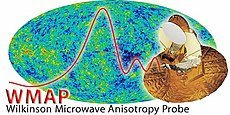Wilkinson Microwave Anisotropy Probe :
From Wikipedia, the free encyclopedia

Artist's impression of WMAP
| |||||
| Names | MAP Explorer 80 | ||||
|---|---|---|---|---|---|
| Mission type | CMBR Astronomy | ||||
| Operator | NASA | ||||
| COSPAR ID | 2001-027A | ||||
| SATCAT № | 26859 | ||||
| Website | map | ||||
| Mission duration | 9 years, 1 month, 19 days | ||||
| Spacecraft properties | |||||
| Manufacturer | NASA / NRAO | ||||
| Launch mass | 835 kg (1,841 lb)[1] | ||||
| Dry mass | 763 kg (1,682 lb) | ||||
| Dimensions | 3.6 m × 5.1 m (12 ft × 17 ft) | ||||
| Power | 419 W | ||||
| Start of mission | |||||
| Launch date | 19:46:46, June 30, 2001[2] | ||||
| Rocket | Delta II 7425-10 | ||||
| Launch site | Cape Canaveral SLC-17 | ||||
| End of mission | |||||
| Disposal | passivated | ||||
| Deactivated | October 28, 2010 | ||||
| Orbital parameters | |||||
| Reference system | L2 point | ||||
| Regime | Lissajous | ||||
| Main telescope | |||||
| Type | Gregorian | ||||
| Diameter | 1.4 m × 1.6 m (4.6 ft × 5.2 ft) | ||||
| Wavelengths | 23 GHz to 94 GHz | ||||
| Instruments | |||||
| |||||
| |||||
| Part of a series on |
| Physical cosmology |
|---|
 |
The Wilkinson Microwave Anisotropy Probe (WMAP), originally known as the Microwave Anisotropy Probe(MAP) was a spacecraft operating from 2001 to 2010 which measured differences across the sky in the temperature of the cosmic microwave background (CMB) – the radiant heat remaining from the Big Bang.[3][4] Headed by ProfessorCharles L. Bennett of Johns Hopkins University, the mission was developed in a joint partnership between the NASAGoddard Space Flight Center and Princeton University.[5] The WMAP spacecraft was launched on June 30, 2001 from Florida. The WMAP mission succeeded the COBE space mission and was the second medium-class (MIDEX) spacecraft in the NASA Explorers program. In 2003, MAP was renamed WMAP in honor of cosmologist David Todd Wilkinson(1935–2002),[5] who had been a member of the mission's science team. After 9 years of operations, WMAP was switched off in 2010, following the launch of the more advanced Planck spacecraft by ESA in 2009.
WMAP's measurements played a key role in establishing the current Standard Model of Cosmology: the Lambda-CDM model. The WMAP data are very well fit by a universe that is dominated by dark energy in the form of a cosmological constant. Other cosmological data are also consistent, and together tightly constrain the Model. In the Lambda-CDM model of the universe, the age of the universe is 13.772±0.059 billion years. The WMAP mission's determination of the age of the universe to better than 1% precision was recognized by the Guinness Book of World Records.[6] The current expansion rate of the universe is (see Hubble constant) of 69.32±0.80 km·s−1·Mpc−1. The content of the universe presently consists of 4.628%±0.093% ordinary baryonic matter; 24.02%+0.88%
−0.87% Cold dark matter (CDM) that neither emits nor absorbs light; and 71.35%+0.95%
−0.96% of dark energy in the form of a cosmological constant that accelerates the expansion of the universe.[7] Less than 1% of the current contents of the universe is in neutrinos, but WMAP's measurements have found, for the first time in 2008, that the data prefers the existence of a cosmic neutrino background[8] with an effective number of neutrino species of 3.26±0.35. The contents point to a Euclidean flat geometry, with curvature ( ) of −0.0027+0.0039
) of −0.0027+0.0039
−0.0038. The WMAP measurements also support the cosmic inflationparadigm in several ways, including the flatness measurement.
−0.87% Cold dark matter (CDM) that neither emits nor absorbs light; and 71.35%+0.95%
−0.96% of dark energy in the form of a cosmological constant that accelerates the expansion of the universe.[7] Less than 1% of the current contents of the universe is in neutrinos, but WMAP's measurements have found, for the first time in 2008, that the data prefers the existence of a cosmic neutrino background[8] with an effective number of neutrino species of 3.26±0.35. The contents point to a Euclidean flat geometry, with curvature (
 ) of −0.0027+0.0039
) of −0.0027+0.0039−0.0038. The WMAP measurements also support the cosmic inflationparadigm in several ways, including the flatness measurement.
The mission has won various awards: according to Science magazine, the WMAP was the Breakthrough of the Year for 2003.[9] This mission's results papers were first and second in the "Super Hot Papers in Science Since 2003" list.[10] Of the all-time most referenced papers in physics and astronomy in the INSPIRE-HEP database, only three have been published since 2000, and all three are WMAP publications. Bennett, Lyman A. Page, Jr., and David N. Spergel, the latter both of Princeton University, shared the 2010 Shaw Prize in astronomy for their work on WMAP.[11] Bennett and the WMAP science team were awarded the 2012 Gruber Prize in cosmology.
As of October 2010, the WMAP spacecraft is derelict in a heliocentric graveyard orbit after 9 years of operations.[12] All WMAP data are released to the public and have been subject to careful scrutiny. The final official data release was thenine-year release in 2012.[13][14]
Some aspects of the data are statistically unusual for the Standard Model of Cosmology. For example, the largest angular-scale measurement, the quadrupole moment, is somewhat smaller than the Model would predict, but this discrepancy is not highly significant.[15] A large cold spot and other features of the data are more statistically significant, and research continues into these.




































